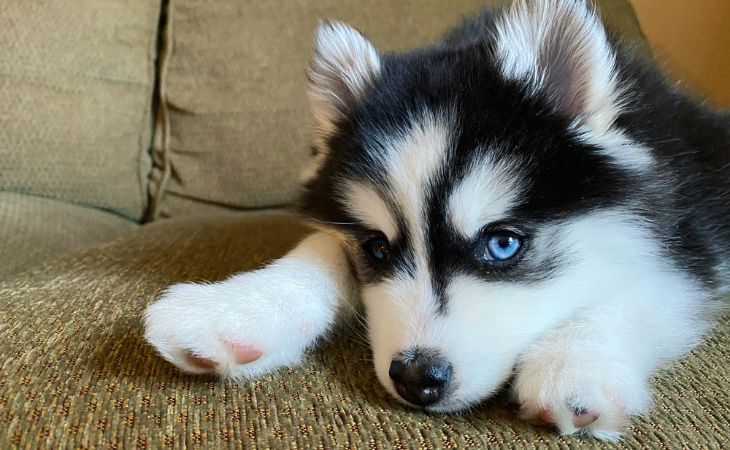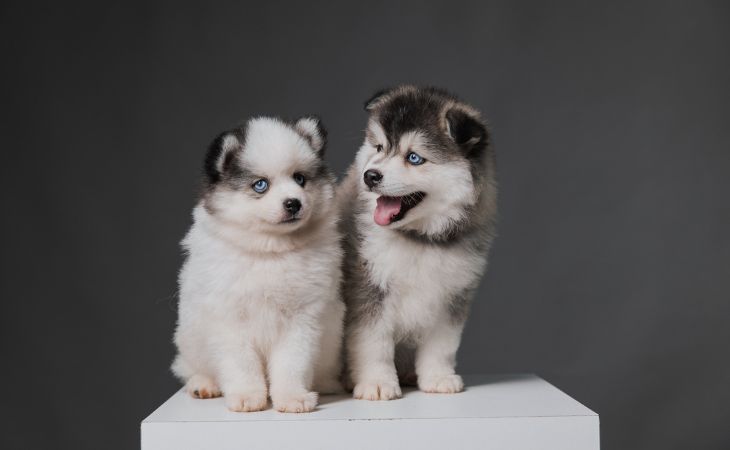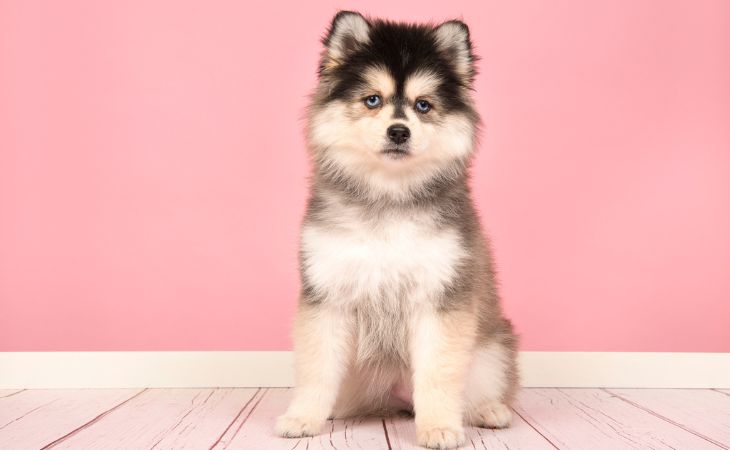Breed standard: Not recognized I Size: Medium I Average lifespan: 15+ years I Temperament: Gentle, affectionate, cheerful, and intelligent I Coat: Medium-long I Origin: United States.
The Pomsky is an affectionate, intelligent, playful, and energetic dog.
The origins of the Pomsky
An interesting cross
The Pomsky is not yet recognized as a dog breed. At the moment, this name refers to a cross between a Pomeranian dog and a Siberian Husky. It is, therefore, a breed in the making that is currently in the process of being stabilized both physically and behaviorally.
The first generation of this dog appeared in the 2000s in the United States. This breed is the result of a cross between a female Siberian Husky and a male Pomeranian dog realized by artificial insemination. The goal was to obtain a dog with the characteristics of the Siberian Husky, but smaller, notably so that the breed would be able to live in apartments.
Thanks to social media, the breed became famous very quickly.
The creation of official clubs
While the Pomsky is not yet recognized as a breed, the amount of Pomsky breeders is multiplying and efforts to stabilize this breed continue. However, it is still very difficult to adopt a Pomsky. When looking to adopt a Pomsky, it is very important to seek out trustworthy breeders. The absence of an official standard can sometimes lead to scams with very high prices for Pomskies and no guarantee of lineage or health.
In the United States and in England, several official Pomsky clubs came to be to defend the status of this breed in the making. Since June 2018, the European Pomsky Club (EPC) has existed. This club has been working on the standardizing the Pomsky.
First, second, or third generation?
When talking about the Pomsky, it’s common to hear about F1, F2, or even F3. These reference the first, second, and third generations.
F1 Pomsky
The term F1 refers to the first generation of the Pomsky that came from the cross between a male Pomeranian dog and a female Siberian Husky from artificial insemination. This type of Pomsky is also referred to as a 50/50 Pomsky, meaning that the dog is 50% Siberian Husky and 50% Pomeranian. A Pomsky F1 that is crossed with a Siberian Husky would result in a Pomsky F1a, which is a Pomsky that is 75% Siberian Husky and 25% Pomeranian. On the other hand, a Pomsky F1 that is crossed with a Pomeranian would result in a Pomsky F1b, which is a Pomsky that is 25% Siberian Husky and 75% Pomeranian.
F2 Pomsky
The second generation is referred to as a F2. This refers to a Pomsky that came from a cross between two F1 Pomskies.
F3 Pomsky
The third generation, F3, comes from a cross between two F2 Pomskies.
If you adopt a dog from a breeder, the breeder must be able to tell you if the Pomsky is F1, F2, or F3. In addition, if the breeder is a member of the European Pomsky Club (EPC), they must agree to record this information on the birth certificate of the dog and on the pedigree delivered by the club.
By adopting a F3 Pomsky, you are more likely to have a small dog when your Pomsky becomes an adult, even though it is not 100% guaranteed. It is also important to note that there is less mixing of genetic heritage in the third generation (and the following generations) which can lead to the risk of genes carrying anomalies. However, it is the job of dog breeders in general, not only for Pomsky breeders, to select the dogs to the limit the risks as much as possible. That is why it is important to do your research before choosing a breeder.

What is the Pomsky’s temperament like?
The Pomsky’s qualities
The temperament of the Pomsky changes from one dog to another, notably depending on the percentage of Siberian Husky or Pomeranian that they have in their genes (F1a or F1b). In general, the Pomsky is usually described as an affectionate, cheerful, and intelligent dog with a gentle temperament. It is not a possessive, aggressive, or cautious dog. However, they can show reserve and a certain level of pride.
Are there any downsides to having a Pomsky?
The Pomsky is a very intelligent dog. As this breed is a cross between a Siberian Husky, this gives the breed a certain leave of determination that is typical of primitive dogs. This dog’s training must be firm, kind, and consistent from a young age. You must be sure to be able to resist this dog’s adorable face.
The Pomsky’s physical characteristics
General
The Pomsky, which hasn’t yet been recognized as an official dog breed, does not have an official standard. Pomskies can have different appearances from individual to individual, their physique is not yet stabilized. Some will have features from the Siberian Husky that are very present, while others will look more like a Pomeranian.
In general, this dog has a balanced and dense body with a relatively small head. The structure of the body of this dog can change depending on the influence of the Siberian Husky or Pomeranian genes. It is listed on the pedigree of the dog: H structure for a Siberian Husky and P structure for Pomeranian. Their eyes can be odd-eyed (two different-colored eyes), dark, or light. Their ears are pointed and well-raised on their head.
The Pomsky can be three different sizes:
- Small Pomsky: these dogs measure around 20 to 30 cm (≈ 7.9 to 11.8 in) at the withers and weigh between 2 and 6 kg (≈ 4.4 and 13.2 lbs),
- Medium Pomsky: between 31 and 40 cm (≈ 12.2 and 15.7 in) for the F1, 30 to 35 cm (≈ 11.8 to 13.8 in) for the F2. Their weight is between 7 and 11 kg (≈ 15.4 and 24.3 lbs) for the F1, and 6 to 9 kg (≈ 13.2 and 19.8 lbs) for the F2,
- Large Pomsky: they measure more than 40 cm (≈ 15.7 in) at the withers and can weigh up to 15 kg (≈ 33 lbs). Only F1 Pomskies can reach this size.
The EPC has been working on standardizing this breed since June 2018.
Head
The Pomsky’s head is medium-sized but relatively small compared to the rest of the body. The top of the skull is slightly rounded and the stop is well-defined.
Their eyes are almond-shaped and can be blue or brown. Odd-colored eyes (each eye is a different color) is also possible thanks to the genes of the Siberian Husky.
In the United States, Pomskies with two blues eyes are the most sought after. It is important to note that this characteristic is very difficult to set for the breeders. Therefore, it is important to be wary of breeders who cross dogs with other Spitz breeders to augment the chances of having a puppy with blue eyes. These dogs are not Pomskies. Breeders who are a part of the EPC commit to realizing DNA tests to reassure future adopters.
Their ears are small and triangular. They are high on the head.
The nose is black for gray, fawn, and black dogs. For dogs with a copper coat, the nose is liver-colored. Lastly, it can be flesh-colored for all-white dogs.
Body
These dogs have a balanced and dense body. They are well-structured.
Their back is straight and solid. The loins are taut. Their rib cage is narrow and slightly raised. The chest of these dogs is high and strong, but should not be too large. The lowest point is situated just behind their elbows.
The shoulder blades are oblique and the arms are slightly oblique towards the back, from the shoulders to the elbows. The elbows are close to the body, without being tucked in, nor out.
The feet are oval-shaped, but not long. They are compact with fur between their toes and paw pads.
The Pomsky’s tail is long and fluffy. Similar to the Siberian Husky and the Pomeranian dog, the tail is sickle-shaped on top of the back.

Coat, color, and grooming
Coat
The Pomsky has a double coat with medium-long hair. The undercoat is soft and dense. The absence of an undercoat during molting season is normal.
Color
The colors are very similar to that of the Siberian Husky. Their coat can be white, fawn, gray, brown, or black, but every color is accepted. The markings look like that of the Siberian Husky.
Grooming and care
Their coat does not need special care. Brushing them once a week is enough to get rid of dead hairs. It is possible to give this dog a bath, an average of once or two times per year is enough.
The Pomsky at a glance
Size and weight:
- Small Pomskies: 20 to 30 cm (≈ 7.9 to 11.8 in) at the withers, 2 to 6 kg (≈ 4.4 to 13.2 lbs),
- Medium Pomskies: F1 Pomskies measure between 31 and 40 cm (≈ 12.2 and 15.7 in) and weigh between 7 and 11 kg (≈ 15.4 and 24.3 lbs). F2 Pomskies measure between 30 and 35 cm (≈ 11.8 and 13.8 in) and weigh between 6 and 9 kg (≈ 13.2 and 19.8 lbs),
- Large Pomskies: (F1) measure more than 40 cm (≈ 15.7 in) at the withers and weigh up to 15 kg (≈ 33 lbs).
Average lifespan and health: The Pomsky can live between 15 and 20 years. When it comes to their health, this dog is rather robust and can resist to extreme temperatures. However, information about this breed’s health is too recent to evaluate major health issues. In addition, as the Pomsky has a tendency to become overweight, you will have to keep an eye on their diet.
Are Pomskies good with children? The Pomsky can live with children, notably if they have known them from a very young age.
Is the Pomsky easy to train? This dog is very intelligent, but sometimes stubborn and determined. When training a Pomsky, it’s important to be firm, but kind. Consistency is key.

